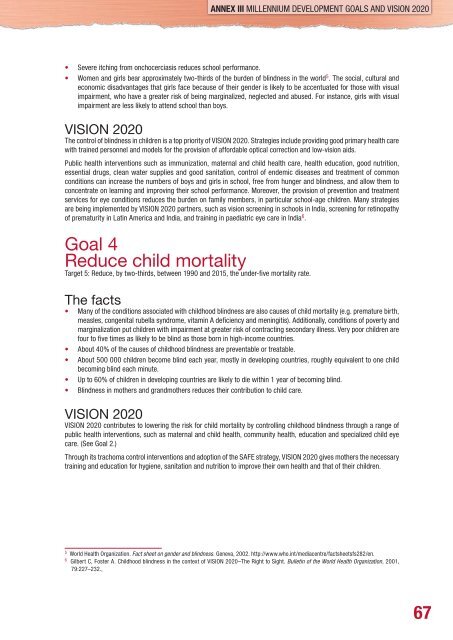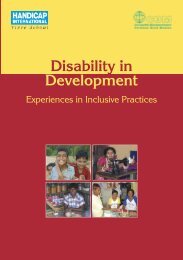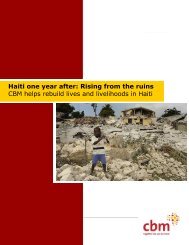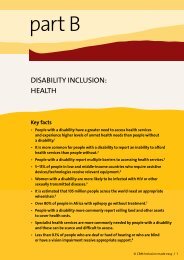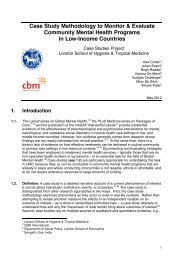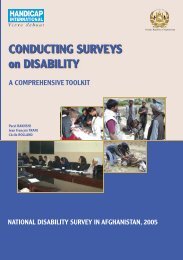Vision 2020 - World Health Organization
Vision 2020 - World Health Organization
Vision 2020 - World Health Organization
You also want an ePaper? Increase the reach of your titles
YUMPU automatically turns print PDFs into web optimized ePapers that Google loves.
ANNEX III MILLENNIUM DEVELOPMENT GOALS AND VISION <strong>2020</strong><br />
• Severe itching from onchocerciasis reduces school performance.<br />
• Women and girls bear approximately two-thirds of the burden of blindness in the world<br />
5 . The social, cultural and<br />
economic disadvantages that girls face because of their gender is likely to be accentuated for those with visual<br />
impairment, who have a greater risk of being marginalized, neglected and abused. For instance, girls with visual<br />
impairment are less likely to attend school than boys.<br />
VISION <strong>2020</strong><br />
The control of blindness in children is a top priority of VISION <strong>2020</strong>. Strategies include providing good primary health care<br />
with trained personnel and models for the provision of affordable optical correction and low-vision aids.<br />
Public health interventions such as immunization, maternal and child health care, health education, good nutrition,<br />
essential drugs, clean water supplies and good sanitation, control of endemic diseases and treatment of common<br />
conditions can increase the numbers of boys and girls in school, free from hunger and blindness, and allow them to<br />
concentrate on learning and improving their school performance. Moreover, the provision of prevention and treatment<br />
services for eye conditions reduces the burden on family members, in particular school-age children. Many strategies<br />
are being implemented by VISION <strong>2020</strong> partners, such as vision screening in schools in India, screening for retinopathy<br />
of prematurity in Latin America and India, and training in paediatric eye care in India 6 .<br />
Goal 4<br />
Reduce child mortality<br />
Target 5: Reduce, by two-thirds, between 1990 and 2015, the under-fi ve mortality rate.<br />
The facts<br />
• Many of the conditions associated with childhood blindness are also causes of child mortality (e.g. premature birth,<br />
measles, congenital rubella syndrome, vitamin A defi ciency and meningitis). Additionally, conditions of poverty and<br />
marginalization put children with impairment at greater risk of contracting secondary illness. Very poor children are<br />
four to fi ve times as likely to be blind as those born in high-income countries.<br />
• About 40% of the causes of childhood blindness are preventable or treatable.<br />
• About 500 000 children become blind each year, mostly in developing countries, roughly equivalent to one child<br />
becoming blind each minute.<br />
• Up to 60% of children in developing countries are likely to die within 1 year of becoming blind.<br />
• Blindness in mothers and grandmothers reduces their contribution to child care.<br />
VISION <strong>2020</strong><br />
VISION <strong>2020</strong> contributes to lowering the risk for child mortality by controlling childhood blindness through a range of<br />
public health interventions, such as maternal and child health, community health, education and specialized child eye<br />
care. (See Goal 2.)<br />
Through its trachoma control interventions and adoption of the SAFE strategy, VISION <strong>2020</strong> gives mothers the necessary<br />
training and education for hygiene, sanitation and nutrition to improve their own health and that of their children.<br />
5<br />
<strong>World</strong> <strong>Health</strong> <strong>Organization</strong>. Fact sheet on gender and blindness. Geneva, 2002. http://www.who.int/mediacentre/factsheetsfs282/en.<br />
6<br />
Gilbert C, Foster A. Childhood blindness in the context of VISION <strong>2020</strong>–The Right to Sight. Bulletin of the <strong>World</strong> <strong>Health</strong> <strong>Organization</strong>, 2001,<br />
79:227–232.,<br />
67


